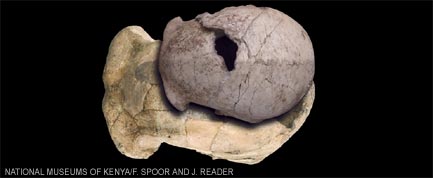
Long before humans and Neanderthals lived side by side in Europe, two other species of early humans were coexisting in Africa, a controversial new study claims.
Researchers working in Kenya have found evidence that Homo habilis survived hundreds of thousands of years longer than previously thought and coexisted with another early human species, Homo erectus.
"There was more than one species of early man for an extended period of time in East Africa," said study team member Frank Brown of the University of Utah.
Ian Tattersall, a paleoanthropologist at the American Museum of Natural History in New York City, said the new fossils support existing evidence that more than one species of Homo, the genus to which our species belong, inhabited Africa about 1.5 million years ago.
"This is definitely evidence for two coexisting lineages," said Tattersall, who was not involved in the study.
The discoveries, detailed in the Aug. 9 issue of the journal Nature, could force scientists to rethink the evolutionary relationship between the two species. But some scientists are skeptical of the new claims.
Sister species
Get the world’s most fascinating discoveries delivered straight to your inbox.
H. habilis is the earliest known member of the genus Homo. And H. erectus was the first human ancestor to resemble modern humans. Due to the many overlaps in their anatomy, it was previously thought that H. erectus was descended from H. habilis. While that might still be the case, the new findings open the possibility that the H. habilis and H. erectus once shared a common ancestor from whom they split.
The researchers identified one of the fossils as a 1.44 million-year-old partial jawbone belonging to H. habilis. Prior to the discovery, the most recent H. habilis fossil was a 1.6 million-year-old specimen discovered by paleoanthropologist Richard Leakey and his team in 1984 and dubbed "Turkana Boy."
The other fossil uncovered at the site is a 1.55 million-year-old skullcap undoubtedly belonging to H. erectus. Its small size compared to other known H. erectus skulls indicates the species might have been sexually dimorphic, with males physically larger than females. Most sexually dimorphic primates, such as gorillas and baboons, tend to mate with multiple partners, so it's possible H. erectus did as well, the researchers say.
The two fossils were discovered in 2000 in eons-old volcanic ash in the Illeret region of Kenya, just east of Lake Turkana where Richard Leakey made his discovery.
According to standard theory, H. erectus evolved from H. habilis, perhaps by way of an intermediate known as H. ergaster. The relationship between H. erectus and us, Homo sapiens, is murky and controversial. According to the "Out of Africa" human migration model, H. erectus was the first early human to leave Africa in substantial numbers, but it was later replaced by members of H. sapiens, which made the same journey.
According to an alternative idea of our species' origin, the scattered bands of H. erectus that originally left Africa simultaneously evolved into H. sapiens in different parts of the world.
Peaceful coexistence
Scientists think Neanderthals and modern humans competed with each other, with the end effect being that our species is the only members of Homo left on the planet. In contrast, H. habilis and H. erectus, appear to have avoided clashing with one another.
"The fact that they stayed separate as individual species for a long time suggests that they had their own ecological niches, thus avoiding direct competition," said study team member Meave Leakey, Richard Leakey's wife.
Based on the shape of their jaws and teeth, scientists think the diet of H. habilis included more vegetation and less meat than H. erectus. This is similar to the situation between gorillas and chimps today: Both apes live in the same habitats, but gorillas eat more tough vegetables than chimps, who are expert hunters.
Not fully convinced
The new findings raise the possibility that H. erectus and H. habilis are actually sister species descended from a common ancestor who lived 2 to 3 million years ago. "Their co-existence makes it unlikely that H. erectus evolved from H. habilis," Leakey said.
However, it's also possible that H. erectus evolved from a small band of isolated H. habilis and the two species continued to live side by side for several hundreds of thousands of years afterwards, said Tim White, a paleoanthropologist at the University of California, Berkeley.
White, who was not involved in the study, said he is not fully convinced the unearthed jawbone does indeed belong to H. habilis, and he thinks many of his colleagues will be skeptical as well. "It's going to be quite a controversial claim," White told LiveScience. "There's a great deal of overlap in not only size but also shape between H. erectus and H. habilis, so their claim that this is H. habilis is likely to be viewed very skeptically by the community"
"The question that people are going to be asking is very simple: How do you know this is not the upper jaw of H. erectus? Since the two are so similar in their jaw and teeth," White added. "And the other thing about H. habilis is that it is not a particularly well defined or well known species even after almost 50 years after its discovery."


